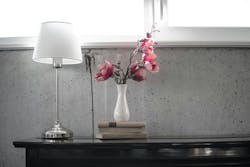Insulated Concrete Forms, known as ICFs, is a construction method typically used in hurricane-prone areas. Some Northern California homeowners are turning to this system to rebuild after the historic wildfires.
ICF systems are generally manufactured with "hollow blocks of fire-resistant foam fitted with rebar," that are then stacked, filled with concrete, and covered with siding, CBS News reports. While many ICF advocates say that the systems are fireproof, University of California architecture professor and architect Dana Buntrock says that's not quite the case. Buntrock explains that construction materials are fire-rated based on the number of hours they will resist a fire, and while concrete has a higher rating, any non-concrete parts of the home like windows or doors remain susceptible to fire.
Unbiased information about ICF homes is hard to find. The Insurance Institute for Business & Home Safety (IBHS), a non-profit concerned with sustainability and resiliency, says it hasn’t studied ICF specificially. An IBHS spokeswoman told KPIX 5 that ICF is considered one component of a home. To be protective against fire, “the whole house has to be built as a system.” Underwriters Laboratories, an independent safety and consulting company, also said it could not provide information about ICF.
